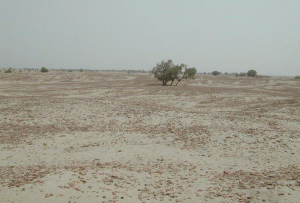Rehman Dheri waiting to be explored and uncovered
Thursday, March 29th, 2012 4:45:05 by Naveed A Bari
Rehman Dheri waiting to be explored and uncovered
Rehman Dheri is a pre-Harappan archaeological site, dated about 4000 BC situated 22 kilometres north of Dera Ismail Khan in the North-West Frontier Province of Pakistan. The site is considered to be one of the oldest urbanized center found to date in South
Asia.
The low mound of this fortified town is visible from Bannu Road. This rectangular mound is covering about 22 hectares and standing 4.5 m above the surrounding field. The fortified town of about ten to fifteen thousand inhabitants shows sign of town planning.
Pottery, and stone and metal tools were found. No seals were found and no writing was discovered, though some forms of engraving or scraping on the pottery were observed.
The site was first explored in 1971 by Dani and excavated by Durrani in 1976-82 and Durrani, Ali and Erdosy in 1990, Rehman Dheir brought new horizon and broadened the scope of the proto historic study of south Asia.
The site is located ideally on the major caravan trade routes between South Asia southern Afghanistan eastern Iran Balochistan and central Asia The importance of the site can be judged from the fact extended the frontiers of the Indus valley to Northwest
and early phase of the Harappan Civilization on the other.
The salient feature of the Indus valley civilization like grid iron pattern town planning uniformed trade network, pictographic /ideographic writing system seals and sailings mass production of ceramic technology have been found in the early and proto form
in Rehman Dheri.
These ideas of the mature Harappan times were conceived first by the people of Rehman Dheri. The side lanes from either side dividing it in to regular blocks. The city was fortified with massive defense system of mud bricks having bastions and watchtower
all the artifacts from Rehman Dheri is an ivory square shaped seal depicted with two mountain goat and a few symbols one side and two scorpions a frog and few symbols on the other.
The final occupational phase of the site is clearly visible on the surface of the mound by eye and also through air photographs. It consisted of a large walled rectangular area with a grid iron network of streets and lanes dividing the settlement into regular
blocks.
Walls delineating individual buildings and street frontages are clearly visible in the early morning dew or after rain and it is also possible to identify the location of a number of small-scale industrial areas within the site marked, as they are, by eroding
kilns and scatters of slag. The surface of the mound is littered with thousands of shreds and artifacts.
The remains of Rehman Dheri are over 4.5 metres deep, and cover a sequence of over 1,400 years beginning at c.3,300 BC. The site represents following periods:
- 3300-3850 BC
- 2850-2500 BC
- 2500-1900 BC
Nothing much is available at the site except thousands of broken utensil remains and stone. Rehman Dheri is considered to have been abandoned at the beginning of the mature Indus phase by the middle of the third millennium BC. The plan of the Early Harappan
settlement is therefore undisturbed by later developments and, as such, represents the most exceptionally preserved example of the beginning of urbanization in South Asia.
Short URL: https://www.newspakistan.pk/?p=17540

















